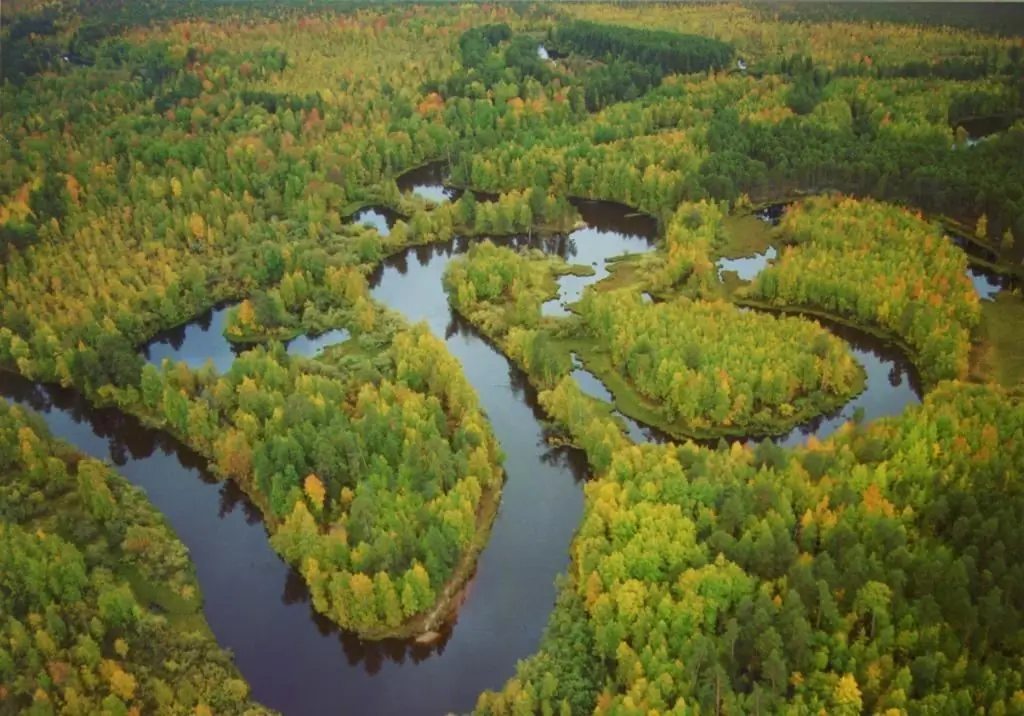- Author Henry Conors [email protected].
- Public 2024-02-12 02:44.
- Last modified 2025-01-23 09:07.
One of the largest tributaries of the Irtysh, flowing within the Khanty-Mansiysk Autonomous Okrug, is the Konda River. You will find a photo, the exact location of the source and mouth, as well as detailed information about the water regime of this watercourse in our article. What settlements are located on the Konda, and what are the features of fishing on this river? We will also tell you about this later.
Konda River (KhMAO): key statistics
Konda is a relatively large river within the KhMAO, the left tributary of the Irtysh (Ob basin). On the map below, the watercourse is highlighted with a purple marker. Key statistics:
- Total length - 1097 km.
- Basin area - 72.8 thousand sq. km.
- Fall - 110 meters.
- The slope is 0.1 m/km.
- Average annual water consumption - 342 cubic meters. m/sec.

The main tributaries of the Konda are Ukh, Ess, Nerpalka, Kuma, Kalym, Yukonda, Mulymya and Mordega. On the river is the city of Uray, as well as a number of towns and villages (Zelenoborsk, Nazarovo, Lugovoi, Mezhdurechensky, Vykatnoy, Kandinsky and others). The Konda River isnavigable for 750 km from the mouth (to the village of Shaim).
In the Konda valley, several oil and gas fields are being actively developed. Appropriate infrastructure is in place: wells, compressor stations, pipelines and access roads. Reindeer herding and fishing are developed in the river basin.
Character of the channel, source and mouth
The Konda River flows out of the swamps located on the Lylimvor upland, and then flows along the Kondinsky lowland. The exact coordinates of the source: 61° 26' 44″ s. sh.; 64° 29' 48 E e. In the upper reaches, it is a narrow (no more than 40 meters) winding river, the channel of which is heavily littered with snags. In the middle reaches, its width increases to 120 meters, and in the lower reaches up to 500-600 meters.

The depth of the river varies from 0.7 to 12 meters. The flow velocity varies from 0.2 m/s in the reaches to 0.8 m/s in the riffles. Channel sediments are mainly represented by sand, clay and silt of dense consistency.
The Konda valley is poorly expressed in the relief. The left bank of the river is low and almost merges with the surrounding landscapes, the right one is more elevated, sometimes steep. The catchment basin is a heavily swampy area overgrown with coniferous and mixed forests. The floodplain of the river is densely indented with small lakes, swamps and numerous branches.
About 15 kilometers from the mouth, the Konda River forms a flowing elongated lake - Kondinsky Sor (see the picture below). The parameters of this reservoir are unstable; during the flood period, it reaches a width of eightkilometers. In low water, it is a network of narrow and winding channels, separated by sandbars and islands.

Konda flows into the Irtysh 45 kilometers from the city of Khanty-Mansiysk. The banks of the river in this place are high and very steep. Geographical coordinates of the mouth point: 60° 42' 23″ s. sh.; 69° 40' 13 in. e.
Features of the water regime
Konda is a river with a mixed supply (with a predominance of snow). The flood period falls on May-August, the autumn low water lasts from 40 to 65 days, but is often interrupted by short-term floods (up to 10-25 centimeters in height). In some years, there may be no low water on the Konda, in such cases, the flood smoothly passes into the phase of winter freeze-up. Numerous lakes and swamps play the role of flow regulators in Conde.
In general, the values of the average annual amplitude of water fluctuations vary from 250 cm in the upper reaches to 360 cm in the lower reaches of the river. The record drop was recorded in 1957 at the Altai-Bolchary section (almost 500 centimeters).
Konda is characterized by the phenomenon of sludge (the formation of loose accumulations of ice on the surface of the channel). As a rule, sludge on the river is observed from 3 to 8 days. Spring ice drift usually lasts no more than five days. Most often, it passes quietly, without the formation of major congestion.
Konda River: fishing and ichthyofauna
The waters of the river are rich in fish. Perch, pike, crucian carp, ide, bream and roach are found here. Thanks to a good food base, individual individuals of the above species reach colossal sizes. Spawning in Kondu also comessterlet and nelma. However, fishing for this fish is prohibited here.
In general, fishing on Konda is an exciting and interesting activity. The depth of the riverbed rarely exceeds eight meters. You can fish both from the shore and from motor boats. The river is replete with many small branches, oxbow lakes and backwaters, where you can find many places for successful fishing.

On the right bank of the Konda, near the village of Lugovoi, there are several floodplain lakes. The water is extremely clean and transparent. These lakes are a great place for fishing from small boats. Pike and perch are excellently caught here. According to rumors, pike weighing up to 30 kilograms can be fished out of these lakes.






